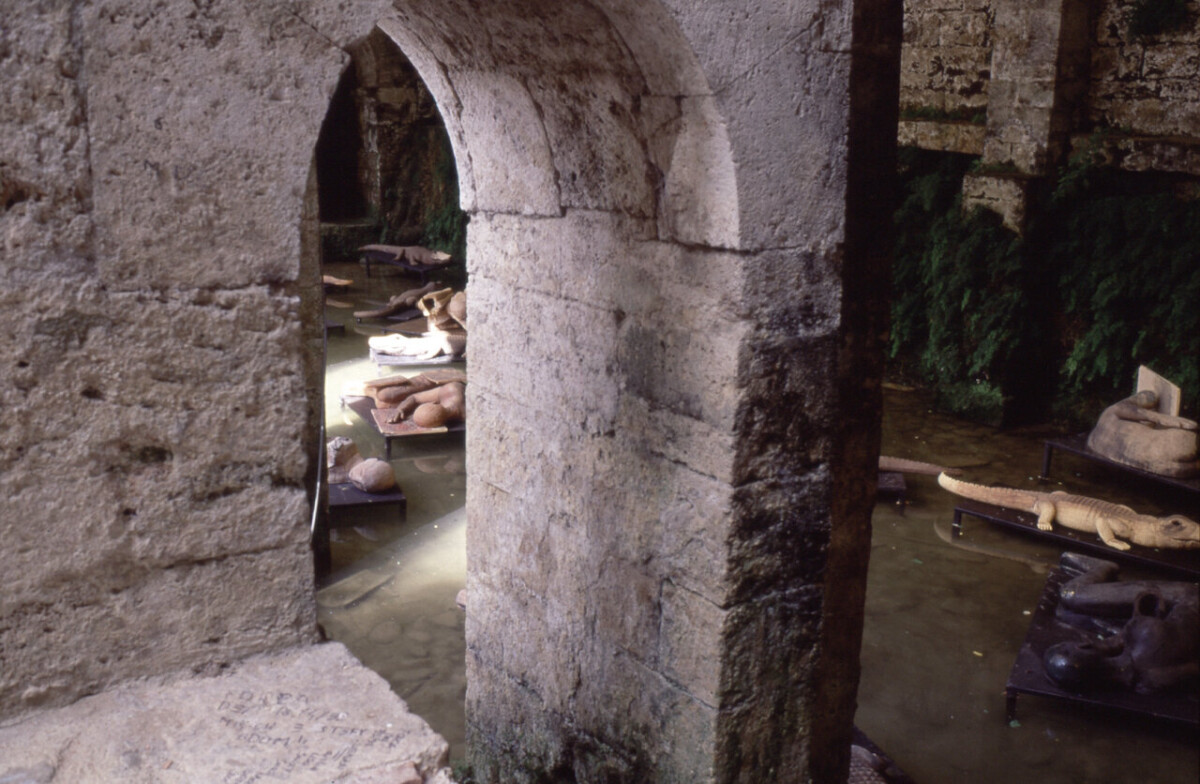The curators of the third edition of Arte all’Arte, Florian Matzner and Angela Vettese, invited Mimmo Paladino to exhibit some of his works and to create the site-specific piece for Poggibonsi, “I Dormienti”, which was later transformed into a permanent installation for Arte all’Arte 2000.
Numerous terracotta sculptures, depicting partly crocodiles and partly humans in a fetal position, have been laid on rectangular dark iron tables: smaller ones for the crocodiles, larger ones for the humans. Each sculpture has a slightly different color from the others, depending on the type of clay used and the materials it was mixed with: sand, oxides, and other elements selected either randomly or instinctively.
Each of the “sleepers” was placed with its table inside the water catchment basin located behind the façade of the fountain, which consists of six wide pointed arches. The works are visible when looking over the parapet. The Fonte delle Fate, a structure dating back to the 11th century, is continuously fed by water seeping from the ground above, and its level changes depending on rainfall. This means the sculptures may sometimes be partially submerged in the water, from which they normally emerge by about ten centimeters.
The casual arrangement of the sculptures, combined with the rigid form of the tables, gives the basin the appearance of a scene that is partly geometric and partly fluid. The vegetation and moss covering the fountain walls, as well as the gentle dripping of water from those same walls, lend the environment a primordial atmosphere.
The Fonte becomes a womb, in whose amniotic fluid various forms of primordial life are immersed—from reptiles to humans depicted in the fetal position, sometimes covered by a kind of placenta, in other cases fragmented and roughly reassembled. This sense of ruin connects to what is distant, unconscious, and lost within our ontogenetic and phylogenetic roots.
Other elements evoking a journey into both collective and individual history include a stylized chariot bearing numerous small faces along its axle and a gigantic helmet, both made of bronze and placed in the square area in front of the arches.
In the sacristy of the nearby Church of San Lucchese, Paladino also installed three paintings, whose formal structure was derived from the background of the painted panels by Memmo di Filippuccio originally created for the sacristy’s furnishings. The artist did not consider it important that the works were not placed in a space accessible to the public, viewing their role as a tribute to the artwork that inspired them as the primary purpose—and welcoming the fact that they would be located in a hidden, yet regularly used, room.
The final part of Paladino’s intervention consisted in the installation of several sculptures, ten paintings, and forty drawings with sword-shaped frames at the keep of Poggio Imperiale, a fortress designed by Sangallo at the request of Lorenzo the Magnificent, and likely a prototype for the construction of the Forte Belvedere in Florence. The imposing structure, originally built for military purposes and abandoned for about sixty years, was cleared out and cleaned for the occasion, in an effort to bring it back to public attention and encourage restoration work."
Angela Vettese, Arte all’Arte III, 1998

